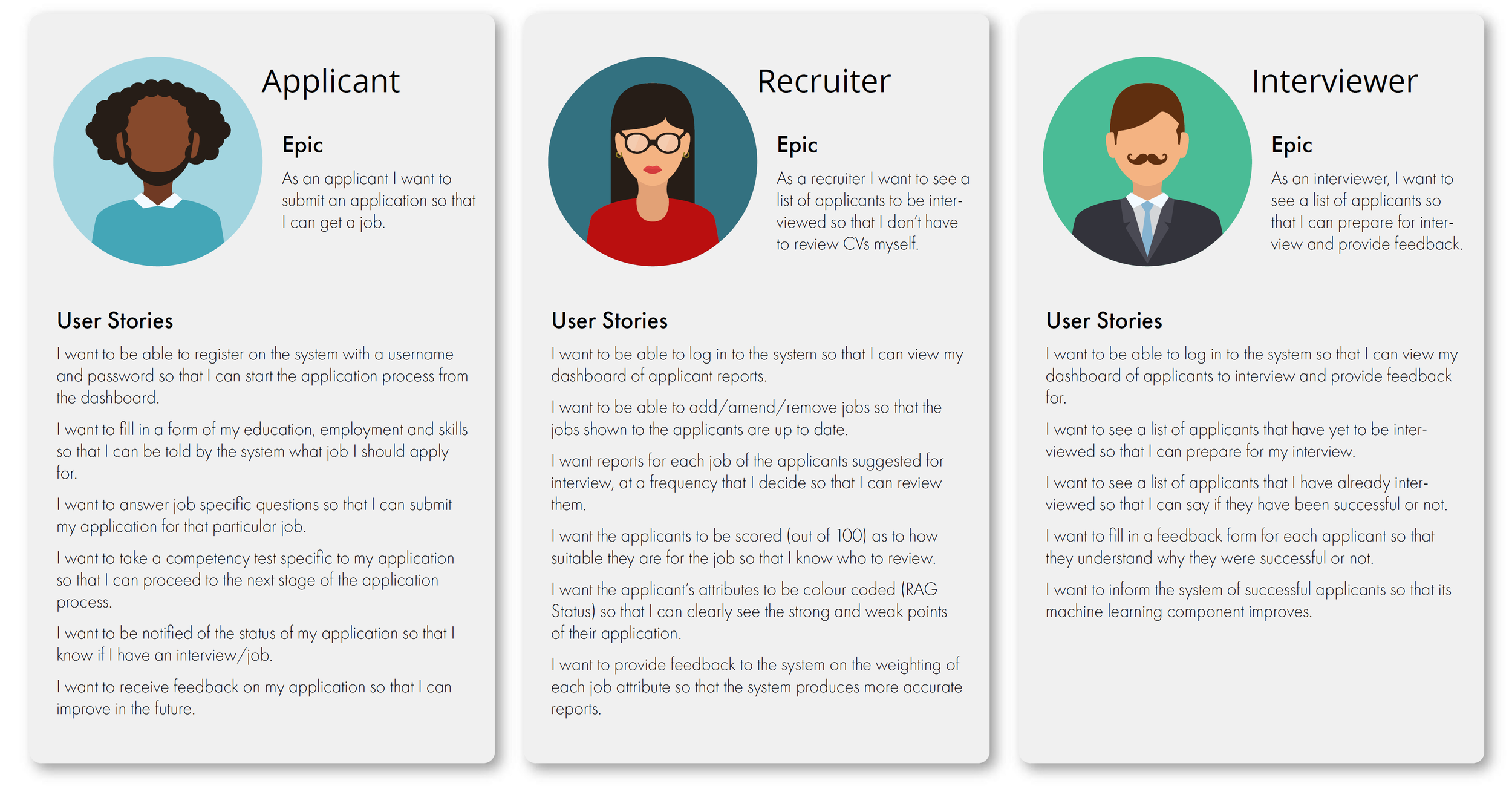Online Recruitment Platform
University group project (conducted in partnership with an industry sponsor) designing and implementing a machine learning system for parsing job applications, complete with a user-friendly dashboard for potential applicants, recruiters, and interviewers.
Project Type
University Coursework for Software Engineering module, in conjunction with an investment bank
Team
6 students
Duration
8 weeks
Role
I acted as the project manager and UX lead for a team consisting of a business analyst and four software developers. I was the stakeholders’ main point of contact and as scrum master organised all sprint meetings and deliverables. I was additionally responsible for the end-to-end UX process, from user research through to the final UI design and testing with the tech team.
The Challenge
Recruitment is a complex and time-consuming process, in part, due to the need for humans to manually review several applicant CVs. It is estimated that between 75% and 88% of applicants are unqualified for a given role, leading to a growing need for automated pre-screening of applicants before a human recruiter is involved. Our main stakeholders had a wish to rapidly recruit new talent, but experienced problems of scalability when dealing with large volumes of applicants manually.
We were asked to design an automated system which implemented machine learning and could fairly and efficiently screen applicant CVs. We also needed to develop a modern and user-friendly web interface for the system, which catered to both prospective applicants and company recruiters/interviewers.
As well as a limited timeframe, the project involved very few opportunities to interact directly with our industry stakeholders. As such, we worked through the intermediary of our course leader, and ensured all decisions were grounded in the provided business requirements and established design principles.
The Solution
User Personas
We began with a detailed review of the brief and stakeholder requirements, followed by research into existing solutions. This evolved into a set of formal system requirements and user stories which were prioritised using MoSCOW (must, should, could, and would).
Our user stories clearly illustrated the individual needs of all three user groups, as shown through the below personas.

User Flow Diagrams
I developed clear and detailed user journeys for the applicant, recruiter and interviewer, as well as separate flows for the log-in/registration process. This enabled me to refine the navigation flow through the system, documenting all assumptions and possible exceptions.
Wireframes
I used a rapid ideation approach through whiteboard sketches to realise the user journeys. Low-fi wireframe versions created on Adobe XD were tested with the rest of the team.









Interactive Prototype
I chose one accent colour for each user to highlight key interactions for an easy journey, keeping the design minimalist overall and utilising natural imagery to reduce stress for the applicant which can often be caused by an overly "formal" interface.
The full prototypes can be accessed using the buttons below (password Teampota2, note this will not work on the Firefox browser)
Features
We implemented a standard form for applicants to submit their qualifications and employment history. This data fed into a classifier which returned a set of jobs and associated compatibility scores. Top ranking jobs were then presented to the applicant in decreasing order of compatibility.
Machine-learning system
More transparency for the applicant
We chose to prominently display a status bar at the top of the applicant’s dashboard, allowing them to quickly see the next steps required. A tutorial also explains the basis for the compatibility score, so they can know what skills to improve.
Reduced work for the recruiter
The recruiter's job specification now only encompasses approval of the machine learning report, whilst still providing the option to view individual applicant’s profiles if necessary to override machine decisions.
Improved feedback system for everyone
The interviewer's dashboard displays a list of applicants requiring feedback (as well as information for upcoming interviews). This means applicants no longer have to request feedback separately. Recruiters can also use this information to analyse the automated sifting process' effectiveness.
Results
The final system was presented to the stakeholder team to overwhelmingly positive feedback. Our interface was described as aesthetically pleasing and considerate of the diverse needs of our different user groups described in the user stories. As well as successfully implementing the machine learning system, our interface supported target users in completing their tasks with minimal frustration or cognitive load, striking an appropriate balance between automation and manual input from the user.
A key challenge of the project was team members lacking experience in agile methodologies. This led to miscommunications and setbacks among the team, and delays to sprints. Here, I learnt the importance of being attentive to the expertise levels of all team members, and tailoring the development process to their individual skills.












